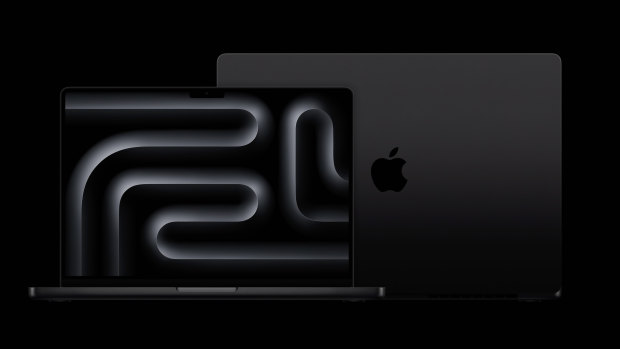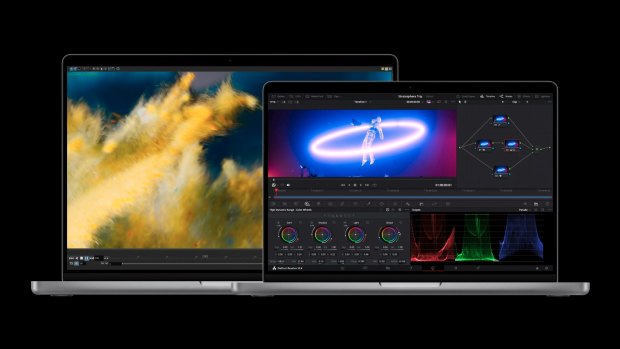Apple’s latest models are powerful, but predictable
Apple’s latest MacBook Pro models are unsurprising. Stacked to the gills with power thanks to the new M3 family of chips, they’re in every other way near-indistinguishable from the past few years of devices.
But that’s not necessarily a bad thing. For any professional with a laptop two or more years old, these could represent significant leaps forward in processing power, battery life, AI processing and more.
The new M3 MacBook Pro still comes in 16-inch and 14-inch models.
And while elements like the keyboard and cases haven’t changed much, the M3 is cutting edge. Built on a new three-nanometre processor, they feature much more efficient CPU cores and a lot of new graphical tricks. All M3s support hardware-accelerated ray-tracing and mesh shading, bringing them close to desktop-class GPUs for gaming and rendering. Plus Apple’s invented a new dynamic caching method that allows the GPU to adjust how much of the shared memory it needs to access in real time.
Physically, the new MacBook Pro is very familiar. It comes in a heavy, but portable 14-inch size or a backpack-stretching 16-inch, both featuring beautiful HDR displays with adaptive 120Hz refresh that I only wish weren’t marred by the unsightly notch up top, which houses the webcam.
They come in silver or a really nice sparkly new black, packing three Thunderbolt-4 ports, a full-size HDMI 2.1 and a full-size SD card reader. I, personally, find the screen and trackpad a little crampy on the smaller model when doing certain kinds of work, but it’s so much more portable. The 16-inch model is more than 35 centimetres wide, and weighs more than two kilograms.
In terms of configurations, the entry-level model is a 14-incher with the standard M3 chip, starting at $2700. This chip has an 8-core CPU, 10-core GPU and up to 24GB unified memory, and while it’s the least of the new chips, it’s absolutely no slouch. Apple says the CPU’s 35 per cent faster than 2021’s M1, and the GPU can deliver the same performance while using half the power.

Black seems like a pretty basic choice, but it looks great in person and isn’t as big a fingerprint magnet as the blue MacBook Air.
In my testing of this new entry-level chip, I found the new caching design paired with AI software like Apple’s MetalFX resulted in surprisingly good graphical performance. The new game, Lies of P, runs in HD and 60 frames per second no sweat.
The rest of the configurations, featuring the beefier M3 Pro or M3 Max, can go in either the 14-inch or 16-inch MacBook Pro – no matter which size you get, there are heaps of options for core count, unified memory and storage, with a theoretical maxed-out machine costing close to $12,000. Very few people will need to go anywhere near that though; an extremely powerful 16-inch model — M3 Max, 36GB memory, 1TB storage — is $5600. More storage is the most expensive optional extra.
Apple’s latest MacBook Pro models are unsurprising. Stacked to the gills with power thanks to the new M3 family of chips, they’re in every other way near-indistinguishable from the past few years of devices.
But that’s not necessarily a bad thing. For any professional with a laptop two or more years old, these could represent significant leaps forward in processing power, battery life, AI processing and more.

The new M3 MacBook Pro still comes in 16-inch and 14-inch models.
And while elements like the keyboard and cases haven’t changed much, the M3 is cutting edge. Built on a new three-nanometre processor, they feature much more efficient CPU cores and a lot of new graphical tricks. All M3s support hardware-accelerated ray-tracing and mesh shading, bringing them close to desktop-class GPUs for gaming and rendering. Plus Apple’s invented a new dynamic caching method that allows the GPU to adjust how much of the shared memory it needs to access in real time.
Physically, the new MacBook Pro is very familiar. It comes in a heavy, but portable 14-inch size or a backpack-stretching 16-inch, both featuring beautiful HDR displays with adaptive 120Hz refresh that I only wish weren’t marred by the unsightly notch up top, which houses the webcam.
They come in silver or a really nice sparkly new black, packing three Thunderbolt-4 ports, a full-size HDMI 2.1 and a full-size SD card reader. I, personally, find the screen and trackpad a little crampy on the smaller model when doing certain kinds of work, but it’s so much more portable. The 16-inch model is more than 35 centimetres wide, and weighs more than two kilograms.
In terms of configurations, the entry-level model is a 14-incher with the standard M3 chip, starting at $2700. This chip has an 8-core CPU, 10-core GPU and up to 24GB unified memory, and while it’s the least of the new chips, it’s absolutely no slouch. Apple says the CPU’s 35 per cent faster than 2021’s M1, and the GPU can deliver the same performance while using half the power.

Black seems like a pretty basic choice, but it looks great in person and isn’t as big a fingerprint magnet as the blue MacBook Air.
In my testing of this new entry-level chip, I found the new caching design paired with AI software like Apple’s MetalFX resulted in surprisingly good graphical performance. The new game, Lies of P, runs in HD and 60 frames per second no sweat.
The rest of the configurations, featuring the beefier M3 Pro or M3 Max, can go in either the 14-inch or 16-inch MacBook Pro – no matter which size you get, there are heaps of options for core count, unified memory and storage, with a theoretical maxed-out machine costing close to $12,000. Very few people will need to go anywhere near that though; an extremely powerful 16-inch model — M3 Max, 36GB memory, 1TB storage — is $5600. More storage is the most expensive optional extra.
